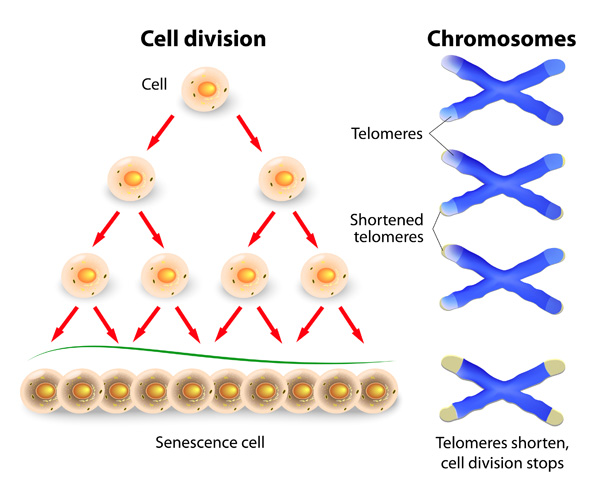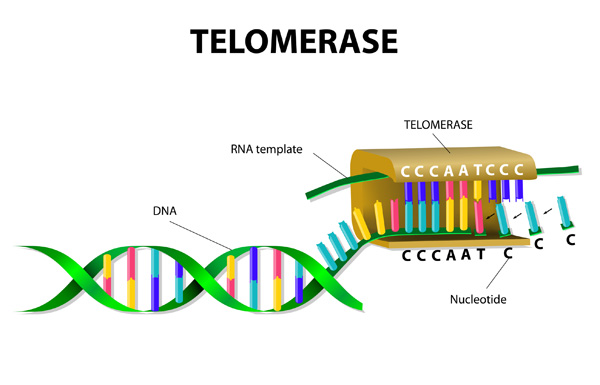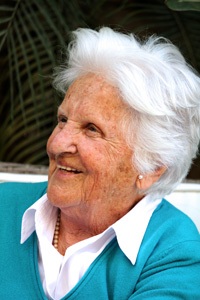If we bypass the marketing term anti-aging, we can focus on a more scientific approach to the internal biological function of the natural age progression of cells. We can examine the external stimuli that superimpose other conditions onto this normal process. Notably, aging is a natural process and it is something that we should embrace throughout our lifetime. We cannot stop it. That said, we can certainly educate ourselves as to how it can be favorably managed. A colleague of mine once wrote, “The skin is like a bank account. Overdrafts are quite expensive and the savings balance will still be at our disposal even in advanced age.”
"Three generations of one family"

How Old Are Cells? – Intrinsic and Extrinsic Factors of Cell Age
Cells are influenced by both intrinsic (endogenous, for example, genetic) and extrinsic (exogenous, for example, external) factors. Therefore, the rate by which one ages is a multidimensional process. Our genomes predetermine our physical and mental performance, cell function, rate of aging, and our potential lifespan. There is also a more subjective aging factor called biological aging which is greatly influenced by the how well the body can repair itself (for example, repair of DNA damage after insult). This process is sometimes accelerated by certain factors which can range from photo damage to disease. This means that the health of our internal body is reflected in our skin. It broadcasts our lifestyle habits, nutrition, and overall health.

The Skin Barrier
The acid mantle and the cells in the stratum corneum are the skin’s first line of defense. The keratinocytes must uphold optimum cell-to-cell communication since they are the rulers throughout the epidermis, sending out thousands of signals to the immune system, melanocytes, and the dermal fibroblasts.
The cell nucleus stores the genetic programming to regulate cell function at an optimum level. Cells have specific requirements that control DNA synthesis, metabolism, building and regulation of the skin’s natural moisture barrier, and the immune and inflammatory response during insults.
An aged epidermal barrier becomes impaired during chronological changes, especially as a result of photoaging. There is an increase in lipid peroxidation and disturbances within the cell membrane. Notably, there is the loss of barrier integrity to hold water within the skin. Be mindful that cell communications may also be repressed during excessive skin care treatments. Deep skin peels, laser and intense pulsed light (IPL) (thermolysis) have the potential of interfering with normal cell communications or elicit the immune system to enter into a wound healing process. Client response varies depending upon the treatment and technique. Carefully consider the skin’s condition and the risks of the chosen modality based on the relevancy of information obtained during the consultation.
Many skin conditions, such as dry, flaky skin, are a result of impairment in the lipid skin barrier function resulting in transepidermal water loss and abnormal desquamation. It becomes vulnerable to bombardment from pathogenic microbes, oxidative stress (reactive oxygen species and free radicals) and ultraviolet radiation. New research reveals that supporting the repair of the acid mantle and skin barrier encourages skin to regain homeostasis (stability and balance). Skin improvement can take 17 weeks, or more, depending upon age and depth of damage. A gradual correction with the use of innovative technologies and treatment, such as light emitting diode (LED) therapy, microcurrent therapy, collagen induction therapy, and the use of skin mimetic ingredients for home care, gradually supports the barrier repair process. The rate of skin correction and results are highly dependent upon the client’s age and skin condition. It is impossible to turn back the hands of time, however, with some thoughtful planning and choice of treatments, remarkable improvement can manifest.
Cellular Repair and Senescence
Cells are designed to survive and contain certain protective mechanisms that are triggered within the DNA to help them repair and also go through division (mitosis). When cell DNA becomes damaged, such as through sun damage or disease, and cannot repair, a gene named the p53 becomes activated in order to destroy the cell. This is known as the apoptotic cell cycle. This is a significant protective mechanism to remove malfunctioning cells and also help prevent cancer.
Progressive changes transpire at the cellular level throughout our entire life span. Known as biologic attrition (deterioration), we call this cellular senescence. An individual’s age is important because there are various factors to consider when closely inspecting the DNA at each age level. Cells, and their organelles, have the ability to build new cells, remove cellular debris, store partially built proteins, and contain a powerful energy source within the cell called the mitochondrion. There may be hundreds of mitochondria per cell depending upon its location. Cells also transport nutrients, water and remove cell wastes through selective channels (portals) across the cell membrane. No matter what time of day or night, the cellular life process silently carries on its work.
Genetic material becomes damaged through the process of living, especially during environmental insults and internal oxidative stress. DNA repair mechanisms begin to deteriorate with older age, especially during menopause and andropause. Lifestyle, sun exposure, and stress contribute to the DNA damage that occurs within the cell. When the damage happens faster than the repair mechanisms, a mutation follows within the division phases of the cell (mitosis). Gene expression and protein function become compromised. The cell fails to divide properly. Its overall performance becomes imbalanced and potentially perilous.
"Telomerase is an enzyme that lengthens telomeres by adding on repeating sequences of DNA. Telomerase binds to the ends of the telomere via an RNA template that is used for the attachment of a new strand of DNA."

Cellular Old Age – The Changing of Gene Expression
Aging can be characterized by our declining ability to respond to stress, an increase of internal imbalance, and escalated risk of aging-associated diseases. Scientists believe that human aging may be defined as the body’s inability to repair itself. Cells divide and duplicate themselves through an activity called mitosis. This process is genetically orchestrated through several phases until the cell divides into two new cells.
The term senescence means that the cell is old, and no longer capable of dividing but is still alive. The final stages of mitosis become blocked and unable to complete the division process. The cell soon becomes a rogue cell secreting destructive enzymes that spread to other cells causing them to become senescent. It is also theorized that cellular senescence may have evolved as a way to prevent the onset of cancer.
"Telomeres ends serve to protect the coding of DNA of a genome. When telomeres shorten to critical lengths, the cell becomes senescent and dies off."

Telomeres
Cells are normally programmed to divide 50 to 70 times. Telomeres are stretches of the DNA that cover the ends of the chromosomes and protect the genes from being destroyed during the cell duplication process. They act as a protective buffer allowing for cell division to occur without losing genes. Each time a cell divides, there is a shortening of chromosomal telomeres that cover the ends of the DNA strands. Telomeres can be analogous to the protective plastic tips at each end of a shoelace preventing the lace from fraying.
At the end of the division process, an enzyme called telomerase replenishes the end of the telomere. Telomerase decreases with each cell division causing the telomeres to become shorter. Eventually the cell can no longer divide and goes into senescence and dies. This signifies an aging cell.
During one’s reproductive years, the body is more vital with the ability to conceive and raise children. Recent research by geneticists at the University of Utah associated shorter telomeres with shorter life span. Individuals over 60 were three times more likely to die from heart disease and eight times more likely to die from infectious disease. Research continues to explore the relationship between the shortening of telomeres and its true relevancy to actual life span and risk of death. Telomere length may vary from person to person. More notably, there is also evidence that telomeres alone do not determine lifespan. A more sensible theory is that a major cause of aging is oxidative stress contributing to the damage to DNA, proteins and lipids. Oxidants are produced from the air we breathe, inflammation, consumption of alcohol, and smoking.
Summary of Factors Involved in the Aging Process
- Chronological age
- Telomere shortening
- Oxidative stress
- Glycation
 Glycation
Glycation
This aging factor occurs when glucose molecules bind to our DNA, proteins and lipids causing them to become less effective. Glycation causes body tissues to malfunction resulting in disease and death. When you see deep wrinkles, skin mottling, and loss of structure, it is a sign of glycation.
Prevention
Glycation can be reduced or prevented with healthy dietary habits that are essential throughout our entire life, especially during pregnancy and childhood. The introduction of processed foods and extreme diets (low fats, no fats, trans fats) during the last 50 years has affected our ability to stay healthy. Nutritional requirements for maintaining healthy cells and body function were programmed into the human genome thousands of years ago. The absence of a daily balance of nutrients, including natural phytochemicals from plants and fruits, high quality protein, and natural fats have raised havoc with our cell membranes and ability to ward off disease. Moreover diet and nutrition account for 30 percent of cancer risk in the United States.This rate increases with age.
Evaluating the skin
Aging begins at the cellular level. One can ascertain the primary and secondary causes of a skin condition through the consultation. Unquestionably, the practitioner requires scientific savoir-faire (know-how) regarding the cells and the body systems to perform this valuable service. This process is essential when developing a skin care management program for your client. Cell function is significantly influenced by chronological age, oxidative stress, nutrition and overall health and disease. Moreover, each phototype (Fitzpatrick I – VI) significantly influences the rate of individual aging.
A primary objective during the consultation is to determine and compare the individual’s natural cellular aging process to the risk factors superimposed throughout one’s life. Examine the stressors (physical, chemical, mental) that influence its normal function.
Chronological age provides clues as to optimum cell function, including how well they communicate and repair. The quality and rate by which they successfully perform their duties is vital to health. You cannot treat the skin without this information. Along with a written health intake form, the use of diagnostic tools, such as a skin scope and skin analyzer, is essential to your consultation.
The following table shows an example of skin conditions that are influenced during the normal progression of cellular damage in reference to age. Every day exposure to the environment, oxygen, pollution, normal cell metabolism and respiration, cell breakdown and repair contribute to cell aging.
Determining the Chronological Age of Skin Cells Age Progression of Cellular Damage
- Under 25 Normally found in the cell membrane through lipid peroxidation.
- 25 – 35 Normally occurs in the cell membrane through lipid peroxidation.
- 35-50 Now moves to mitochondria DNA and is called mitochondria aging.
- Over 50 Cells move into senescence and have abnormal cell functioning.
*Adapted from Advanced Skin Analysis by Florence Barrett-Hill
During the consultation, consideration should include how each condition affects the cells and systems within the skin: keratinocytes, melanocytes (pigment), corneocytes, immune cells (immune system), fibroblasts (collagen, elastin, ground substance), and the circulatory system (blood and lymph). Moreover consideration of the blocking factors is essential since they interfere within normal cell function and may effect risk factors and potential for success with your client. Then, closely examine the conditions superimposed onto the normal aging process such as vascular (telangiectasia), pigmentation, glycation (deep wrinkles) and more. Blocking factors include poor nutrition and/or nutrient absorption, essential fatty acid deficiency, medications, cancer and other diseases, and of course, high UV exposure.
Aging, Attitude, Acceptance
Life span 100 years ago was about 45 to 50 years of age. Today, we are living well into our 80s and beyond and require a quality of life that includes remaining healthy and vital into our older years. Life’s turning points begin to show the subtle changes as our children begin to leave the nest. This life event becomes an opportunity for entering into the next phase of life being creative and happy.
One cannot reverse the human aging process. It is a natural biological occurrence genetically programmed into our species for thousands of years. What is essential is our quality of living and the foresight to take care of ourselves when we are younger so that extrinsic factors do not get in the way of us appearing beautiful or handsome no matter what our age.
References
1 Lautenschläger, Hans, PhD, Regeneration – the potentials from cosmetic products. Beauty Forum, 2003 (3), 72-74 Retrieved from http://www.dermaviduals.com/cms/upload/Publikationen_english/BF-3-03-Regeneration-engl.pdf
2 Pugliese, P.T., Advanced Professional Skin Care – Medical Edition. The Topical Agent, Bernville, PA. pp244-245 (2005)
3 Barland, C.O., Elias, P.M., and Ghadially, R., The Aged Epidermal Permeability Barrier: Basis for Functional Abnormalities. Skin Barrier edited by P.M. Elias and K. R. Feingold. Taylor and Francis. pp 536-538(2006)
4 Elias, P., Feingold, K.R. Why A Barrier and What Do We Mean by “Barrier Function”? Skin Barrier edited by P.M. Elias and K. R. Feingold. Taylor and Francis. pp 1-3 (2006)
5 Dermascope Sept. 2012 article on Corneotherapy. Link: http://www.dermascope.com/chemistry/corneotherapy-a-sensible-approach-to-understanding-theskin?highlight=WyJhbGV4YW5kcmEiLCJqIiwiemFuaSIsImFsZXhhbmRyYSBqIiwiYWxleGFuZHJhIGogemFuaSIsImogemFuaSJd#.UySr31ybY1c
6 Pugliese, P.T., Draelos, Zoe D. , Physiology of the Skin, Third Edition. Allured Business Media. pp 422-423 (2011)
7 Pugliese, P.T., Advanced Professional Skin Care – Medical Edition. The Topical Agent, Bernville, PA. pp248-249 (2005)
8 Are Telomeres The Key To aging And Cancer? Learn.Genetics, Genetic Science Learning Center, Univ. of Utah Health Sciences. Retrieved from http://learn.genetics.utah.edu/content/chromosomes/telomeres/
9 IBID, Pugliese
10 IBID, Learn.Genetics
11 IBID, Learn.Genetics
12 IBID, Learn.Genetics
13 IBID, Telomeres and Aging
14 Zani, Alexandra J. (March 2014) The Essential in Fats: A Global Perspective for Healthy Ski Cells. Retrieved from http://www.skininc.com/skinscience/ingredients/248578091.html
15 Cancer.org http://www.cancer.org/acs/groups/content/@epidemiologysurveilance/documents/document/acspc-027766.pdf
16 Barrett-Hill, Florence. Advanced Skin Analysis. Virtual Beauty, 2004 and on-line course. www.pastiche-net.nz
17 Setterfield, Lance, MD. The Concise Guide to Dermal Needling – Expanded Medical Edition. Acacia Dermacare, Canada (2013)
 Alexandra J. Zani is an international educator, researcher and author with a background in cell biology and medical. Her passion for education resulted in receiving numerous advanced certifications both in the United States and abroad. Zani earned an instructor license for aesthetics/cosmetology, is NCEA Nationally Certified, certified in Oncology Esthetics®, and the Pastiche Method® of Skin Analysis. She is a member of the International Association for Applied Corneotherapy (IAC). Zani presents education for advanced aesthetic technology including microcurrents, LED, and non-ablative laser. She is a specialist in the anti-aging sciences, including the effects of nutrition, lifestyle, and the mind/body connection.
Alexandra J. Zani is an international educator, researcher and author with a background in cell biology and medical. Her passion for education resulted in receiving numerous advanced certifications both in the United States and abroad. Zani earned an instructor license for aesthetics/cosmetology, is NCEA Nationally Certified, certified in Oncology Esthetics®, and the Pastiche Method® of Skin Analysis. She is a member of the International Association for Applied Corneotherapy (IAC). Zani presents education for advanced aesthetic technology including microcurrents, LED, and non-ablative laser. She is a specialist in the anti-aging sciences, including the effects of nutrition, lifestyle, and the mind/body connection.
Want to read more?
Subscribe to one of our monthly plans to continue reading this article.